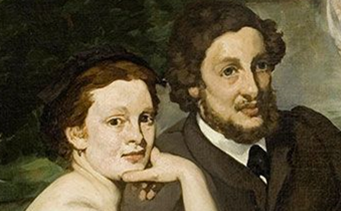This post focuses on a great Pennsylvania painter- Cecilia Beaux. While we have not yet found a definitive link between
Francis Quirk and Cecilia Beaux, they certainly knew of each other and most
probably met. Cecilia Beaux was the first female faculty member at the
Pennsylvania Academy of Fine Arts (PAFA). Quirk was active in the Philadelphia
art community and exhibited
at PAFA. Bethlehem painter Walter
Baum and Lehigh University Art Gallery exhibitor studied under Beaux
at PAFA. Both Beaux and Quirk painted portraits and had realist tendencies
although both would experiment with other styles: the former towards
impressionism and the latter towards
cubism.
One of Beaux' best paintings featured her brother in
law Henry
Drinker, a railroad executive who would later serve as the fifth President
at Lehigh
University. She executed the portrait in 1898, not long after she studied
in Paris at the Academy Julian, and it shows the influence of the impressionist
movement that began in the 1860's. The brushwork is languid and flowing in the
sitter's clothing. The relaxing palate is light with whites, beiges, and tans.
The lolling cat adds a pleasant and almost humorous element as it contentedly
closes its eyes.
 |
| Man with a Cat (Henry Sturgis Drinker) 1898 by Cecila Beaux |
Beaux also structures the painting well; using the archways and doors to emphasize depth.
Francis Quirk and
Norman Rockwell also used this same technique.
 |
| The Summer Pastor by Francis Quirk |
 |
| Norman Rockwell The Bottom Drawer |
Below we provide a Beaux self-portrait from 1894, which was
five years after her return from studying in Paris. The painting is a mix of
styles with her face carefully executed in a realist style, above a dress portrayed
in an impressionist style with loose free-flowing brush strokes.
 |
| 1894 Self-Portrait by Cecilia Beaux |
The painting of Sarah Leavitt below hangs in Paris’ Musee deOrsay. Here again the cat adds an engaging element. But the coloring of the
face is reminiscent of the work of Manet. Again, we do not know if the two met. But they were in Paris at the same time and Beaux certainly saw his work. The faces in his works seem to have a
certain flatness that gives his work a distinctive quality.
 |
| Sita and Sarita (Jeune Fille au Chat), a portrait of Sarah Allibone Leavitt, 1893–1894 the Musée d'Orsay in Paris |
Below, I have pasted three of Manet's faces for comparison.
Finally, below are images of a host of Beaux paintings. She made great art. You can learn more about her here.
















No comments:
Post a Comment